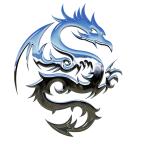FireShot Capture 2011 - See_ World & Mythology Of Apple TV+ S_ - https___screenrant.com_see-show.jpg
Created by Steven Knight, See takes place in a dystopian America that’s been ravished by a deadly virus, leaving two million survivors blind. Here are the universe rules for the new Apple TV+ series, and how they apply to the central conflict.
See’s origin story revolves around a big secret. Once upon a time, Alkenny tribal leader Baba Voss (Jason Momoa) met a pregnant woman, Maghra (Hera Hilmar), who reveals that a stranger named Jerlamarel is the father. When twins Kofun and Haniwa are born with sight, Baba is naturally confused and must protect his new wife - and the secret - primarily because a local tribe is known for burning villages when they detect witchcraft. Over the years, the legend of Jerlamarel spreads, thus infuriating a tribal leader named Queen Kane (Sylvia Hoeks). She believes that sight is a sin, and plans to find the twins who can see.
In See, the major twist is that Jerlamarel left a secret box of knowledge for the twins, full of weird things known as “books.” Alkenny member Paris (Alfre Woodard) spoils the secret, allowing the now-grown up Kofun (Archie Madekwe) and Haniwa (Nesta Cooper) to secretly educate themselves about the ways of the world, making them even more of a threat to Queen Kane. Here are the various layers of See’s world, and how the main characters must navigate it.
THE FUTURE WORLD OF SEE
FireShot Capture 2012 - See_ World & Mythology Of Apple TV+ S_ - https___screenrant.com_see-show.jpg
The futuristic world of See is all about duality: right and wrong, facts and fiction, truth and lies. On the surface, however, necessity is key. The main characters protect their land for obvious reasons - it’s what they know best. Within these settings, specific cultures emerge, which ultimately create the narrative foundation for the brewing war between Baba Voss’ Alkenny people and Queen Kane, a woman who embodies the sacred and the profane (she prays while pleasuring herself). In this world, though, moral concepts associated with the distant past don't matter. It's a much different world now; the inhabitants believe more in connecting with the Gods than thinking about ancient ways of thinking.
Because the worldview of See’s characters is limited to senses and interpreting information, they must be especially careful when navigating outside their comfort zone, evidenced by a third-episode Alkenna trip to a nearby festival. Word of mouth has traveled about Jerlamarel, and innocent humans are now being sacrificed. This is the tipping point for Queen Kane, who clings to power while two teenagers use theirs gift of sight and knowledge to affect the present. In See, the old ways die and new rules are established.
JASON MOMOA'S BABA VOSS & HIS TRIBE
FireShot Capture 2013 - See_ World & Mythology Of Apple TV+ S_ - https___screenrant.com_see-show.jpg
In the See universe, Baba’s logic is based on what he can sense and feel. He’s a minimalist and values the bond of his tribe. An early scene shows how the Alkenna operate when their village is attacked: there’s a battle horn, a ritualistic dance, and specific language (“Chet-Chet”) that’s used to signal an impending attack. Adult Kofun later uses the same phrasing when his Baba is attacked by an old enemy, which leads to See’s most violent sequence. There's a give-and-take dynamic throughout - knowing when to prioritize communication first, and action second, or vice versa.
See is essentially about a battle between old school philosophies and new school thinking. In this futuristic world, however, Baba IS the old school, and can’t possibly understand archaic, out-of-date concepts like reading and math. He makes this clear when speaking with Kofun and Haniwa, both of whom are now familiar with Harper Lee's To Kill a Mockingbird and George Orwell's 1984. Fortunately, Baba does indeed have tremendous combat and leadership skills. But the See narrative suggests that some of the Alkenna people are curious about his motivations. As the Jerlamarel myth intensifies, Baba’s community will be forced to make some difficult choices about what they know to be true, if only because there are two twins who were born to see, and to experience the world much differently than every other human survivor.
Torrent Invites! Buy, Trade, Sell Or Find Free Invites, For EVERY Private Tracker! HDBits.org, BTN, PTP, MTV, Empornium, Orpheus, Bibliotik, RED, IPT, TL, PHD etc!
Results 1 to 1 of 1
Thread: The World Of See Explained
Hybrid View
-
11-04-2019 #1Super Moderator





















- Reputation Points
- 915622
- Reputation Power
- 100
- Join Date
- Dec 2016
- Posts
- 22,758
- Time Online
- 509 d 4 h 24 m
- Avg. Time Online
- 3 h 57 m
- Mentioned
- 2782 Post(s)
- Quoted
- 806 Post(s)
- Liked
- 16937 times
- Feedbacks
- 381 (100%)
The World Of See Explained
WHAT WE DO IN LIFE ECHOES IN ETERNITY


 1Likes
1Likes LinkBack URL
LinkBack URL About LinkBacks
About LinkBacks





 Reply With Quote
Reply With Quote





